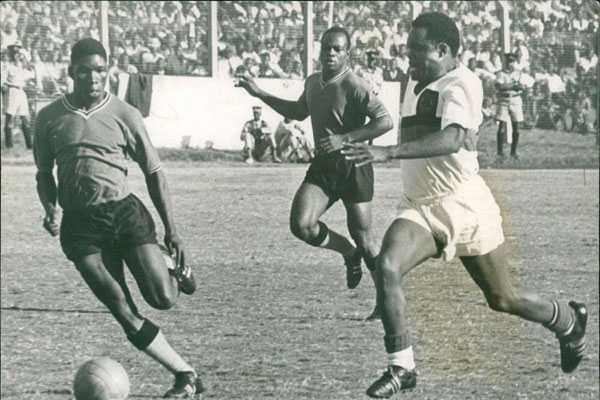Long before stadium lights and live broadcasts turned sport into spectacle, one man carried Kenya’s dreams on his feet. Joe Kadenge, born in 1935 in Western Kenya, was not merely a footballer — he was a storyteller whose language was motion. When the ball touched his boots, it seemed to obey rhythm, not gravity.
In the years after independence, as a young nation searched for its identity, Kadenge offered something beyond sport — a sense of artistry. On dusty grounds and packed terraces, fans learned to chant the phrase that still echoes in national memory: “Kadenge na mpira!” — Kadenge with the ball!
It wasn’t just a call from commentators. It was a heartbeat.
The Early Game
Kadenge’s rise began in the 1950s and 60s, when football across East Africa was played for pride more than pay. He first dazzled for Maranatha FC, then for Abaluhya FC (later AFC Leopards), leading them into the regional spotlight.

Club: Maragoli United F.C. (1963), Abaluhya FC (1963-1975)
Position: *WF
Side: RF/BS
Age: 28-32 years (16/03/1935)
This was a time when Kenya’s athleticism was just beginning to find its footing internationally — the same period chronicled in the early chronicles of Kenyan sport’s global awakening.
While other heroes were fighting on tracks and fields, Kadenge turned every touch into theatre. His dribbles, sudden bursts, and graceful passes gave fans something deeper than victory — they gave joy.
In the Gossage Cup, the tournament that later evolved into the CECAFA Championship, Kadenge became the face of Kenya’s footballing renaissance. His most famous moment came in 1973, when he scored the fastest ever goal in an international match against Zanzibar, a record that would stand for decades.
(To understand how this era’s regional competitions mirrored Kenya’s shifting political alliances, see a study of East Africa’s inter-state rivalries through sport).
The Artist and His People
Kadenge’s football was more than skill; it was emotion made visible. He played in an age when boots were worn thin and sponsorships were unheard of, yet the connection between player and crowd felt almost spiritual.

His artistry reflected the same creative defiance that shaped Kenya’s post-colonial cultural scene — a spirit explored in the narratives of musicians who transformed Kenya’s popular sound after independence.
Through movement and rhythm, Kadenge captured what words could not: that freedom could be expressed even within the boundaries of a football pitch.
Mentor, Symbol, Patriot
When the cheers faded, Kadenge never left the game. He became a coach, a team manager, and an elder statesman of sport. Generations of players sought his counsel not for tactics, but for perspective.
In the bleachers, wrapped in his signature shawl, he watched every match as though it were his first. Even as age dimmed his strength, the fire in his eyes never wavered.

His humility and commitment placed him among the quiet nation-builders who emerged after the long colonial struggle — the same kind of civic dedication chronicled in accounts of Kenya’s post-independence leadership and reform movements.
In recognition of his contribution, Kadenge received the Order of the Grand Warrior, one of Kenya’s highest honors. When he passed away in July 2019, tributes came from all walks of life. President Uhuru Kenyatta called him “a true patriot and sporting legend.”
The Legacy of “Kadenge na Mpira”
Joe Kadenge never needed a stadium named after him; his name already lives wherever a child chases a ball across a dusty field. His artistry bridged generations — from colonial restrictions to a freer, prouder Kenya that found unity in the beauty of play.
His story belongs to the same continuum of endurance and self-belief that gave the world Kipchoge Keino on the track and Joe Kadenge on the turf.
(For a broader journey through Kenya’s sporting evolution, see a reflection on how the nation’s athletes turned adversity into triumphs across multiple disciplines).
Kadenge made football feel like freedom — and in a country still defining itself, that may have been his greatest goal.
